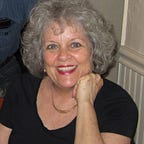Why I Haven’t Read White Fragility
The last time I felt “fragile” about being White I was 7 years old. That’s when my critical race education began, on Fifth Street, Northeast in Washington, DC in 1958. I don’t know how much my parents — Gib and Libby Sangster — understood what they were doing by moving into a mixed race neighborhood or how it would impact me for the rest of my life. I do know that I’m grateful for them and the decisions they made, however uninformed they might have been. They were transplants from New York, had met in Greenwich Village and were part of an artists’ community; plus, my father was a jazz fanatic, so this wasn’t the first time they had crossed racial lines. I cherish the photo of my father at Cafe Bali on Fourteenth Street, seated across from Billie Holiday — Lady Day — in the company of two other Black women whose identities remain unknown.
The concept of gentrification wasn’t common parlance in those days. My parents had no money for a deposit or mortgage payments and I’m sure they were welcomed by National Capital Bank and other lenders at least partly because they were White. Our neighbors next door or across the street didn’t have such luck and over the next decade the neighborhood became more and more white-washed, more middle class than working class.
But in those early years, I learned my identity as that little White girl. I learned from Jane Roundtree, I learned from Pig and Papoose (I don’t know if I ever knew their “real” names), I learned from Tawanna and Margaret who I think was an only child like me and hated me because I could skate faster than she could on those rattly metal skates that you had to tighten up with a key. We used to skate up and down the street till dark and sometimes on the slick marble of the Supreme Court a few blocks away, something no kid could ever do today.
One of my first lessons in White privilege came in third or fourth grade at Peabody Elementary School when I was selected to play Mother Goose in the class play and had to walk around the circle of my classmates, pronouncing each one of them one thing or another, being the eight year old little White girl authority that I was. Luckily, I got transferred to what would now be called a magnet school — Amidon Elementary in Southwest — because the curriculum at Peabody wasn’t sufficiently challenging. I don’t know if my parents knew this either, that this move would be another essential piece of my education in racial and class identity. At Amidon, followed by Jefferson Junior High (now known as an Academy) and finally Western Senior High (transformed in the early 70’s into Duke Ellington School of the Arts) I’d be surrounded by a diverse population of peers, most of whom were a lot smarter and more academically advanced than I was.
Sure, there were some smart White students, and some of them were my close friends. But when I find myself today in a group of White people who are struggling with racial identity, racism and what it all means in today’s fractured world — especially if it’s a group that wants me to read White Fragility — something in me bristles, something in me that has roots in those formative years when one of my most prized accomplishments was being accepted and welcomed into the fold of my Black peers who dominated our social and academic world. I still see myself standing at the bus stop outside of Jefferson, looking up at Virginia Johnson — who even at 13 or 14 had the regal posture of a prima ballerina and would go on to found the Dance Theater of Harlem. Or trading caricatures with Thad Mumford (I did have a bit of my father’s artistic ability) who became a well-known writer and television producer, sadly dying too young at 67.
A couple of times a year, a group of about 10 or 20 of the Western Senior High Class of 1968 gathers for informal luncheons around DC. We had our 50th Reunion extravaganza and there might be more reunions to come. But these get-togethers feed my soul. The backdrop to our graduation was the Reverend Martin Luther King Jr.’s assassination. We don’t talk about it, but I believe each of us in our own way knows this is what binds us together, what keeps us coming back, even as our ranks dwindle year after year. I don’t know if I’ll ever bring myself to read White Fragility. I suppose I could pick up a used copy at Capitol Hill Books; maybe I’ll learn something I don’t already know but it’s hard for me to imagine what lessons my own life experience haven’t taught me.
